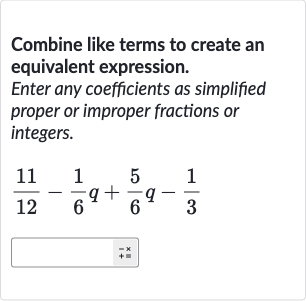Full solution
Q. Combine like terms to create an equivalent expression.Enter any coefficients as simplified proper or improper fractions or integers.
- Combine like terms involving q: Combine like terms involving q.Simplify the fraction by dividing both numerator and denominator by .
- Simplify the fraction : Combine the constant terms.To combine these fractions, find a common denominator, which is . can be written as .Now subtract from .
- Combine the constant terms: Combine the results from the previous steps to form the final expression.
More problems from Simplify variable expressions involving like terms and the distributive property
QuestionGet tutor help
QuestionGet tutor help
QuestionGet tutor help
QuestionGet tutor help
QuestionGet tutor help

